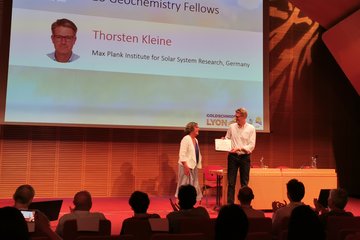Alle Typen
21.
Zeitschriftenartikel
Upper mantle structure across the Trans-European Suture Zone imaged by S-receiver functions. Earth and Planetary Science Letters 458, S. 429 - 441 (2017)
22.
Zeitschriftenartikel
Planned products of the Mars Structure Service for the InSight mission to Mars. Space Science Reviews 211, S. 611 - 650 (2017)
23.
Zeitschriftenartikel
Planned Products of the Mars Structure Service for the InSight Mission to Mars. Space Science Reviews 211, S. 611 - 650 (2017)
24.
Zeitschriftenartikel
Identification of new events in Apollo 16 lunar seismic data by Hidden Markov Model-based event detection and classification. Journal Geophysical Research 120, S. 1620 - 1645 (2015)
25.
Vortrag
Crustal thickness across Central Europe from seismic noise autocorrelation analysis. Rocks \& Stars II, Göttingen, Germany (2017)
26.
Vortrag
A new moonquake catalog from Apollo 17 geophone data. European Geosciences Union General Assembly, Vienna, Austria (2017)
27.
Vortrag
Crustal and shallow subsurface seismology on InSight. ISSI-BJ Lunar and Planetary Seismology Forum, Beijing, China (2017)
28.
Vortrag
Crustal S-velocity from P-wave polarization - Tests with receiver functions from Instaseis Mars synthetics. 43. Sitzung der AG Seismologie, Bad Breisig, Göttingen (2017)
29.
Vortrag
The InSight mission - single station seismology on Mars. Lunchtime Seminar of Geophysics Section, München, Germany (2016)
30.
Vortrag
Rayleigh wave ellipticity modeling and inversion for shallow sub-surface structure at the InSight landing site in Elysium Planitia, Mars. 42. Sitzung der AG Seismologie, Bad Salzschlirf, Germany (2016)
31.
Vortrag
Upper mantle structure across the Trans-European Suture Zone from S-receiver functions. European Geosciences Union General Assembly, Vienna, Austria (2016)
32.
Vortrag
InSight - a geophysical mission to planet Mars in 2016. Institutskolloquium Institut fur Erd- und Umweltwissenschaften, Potsdam, Germany (2015)
33.
Vortrag
New events identified in Apollo 16 lunar seismic data by Hidden Markov model based event detection and classification. 41. Sitzung der AG Seismologie, Wildbad-Kreuth, Germany (2015)
34.
Vortrag
New seismic events identified in the Apollo lunar data by application of a Hidden Markov Model. European Planetary Science Congress, Nantes, France (2015)
35.
Vortrag
Preparing the installation of station ELYS: The InSight mission to Mars. 40. Sitzung der Arbeitsgemeinschaft Seismologie der FKPE, Gross-Doelln, Germany (2014)
36.
Vortrag
Red planet, seismologically dead planet? The InSight mission to Mars. Working Group Seminar General Geophysics/Seismology, Potsdam, Germany (2014)
37.
Vortrag
The outline of a cratonic margin: Mapping structure across the Trans-European Suture Zone with receiver functions. Seminar aktuelle Forschungsthemen, Kiel, Germany (2014)
38.
Poster
Crustal thickness and vp/vs-ratios from single-station auto-and cross-correlations of seismic noise. European Geosciences Union General Assembly (EGU), Vienna, Austria (2018)
39.
Poster
Martian crustal S-wave velocities from apparent incidence angles - a case study for InSight. European Geosciences Union General Assembly, Vienna, Austria (2018)
40.
Poster
Martian crustal S-wave velocities from P-wave polarization - a test study for InSight. 49th Lunar and Planetary Science Conference, The Woodlands, Texas (2018)











